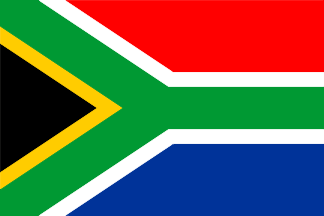Symbolism
The national flag was designed by a former South African State Herald, Mr Fred Brownell, and was first used on 27 April 1994. The design and colours are a synopsis of principal elements of the country's flag history. Individual colours, or colour combinations represent different meanings for different people and therefore no universal symbolism should be attached to any of the colours. The central design of the flag, beginning at the flagpost in a 'V' form and flowing into a single horizontal band to the outer edge of the fly, can be interpreted as the convergence of diverse elements within South African society, taking the road ahead in unity.
The theme of convergence and unity ties in with the motto Unity is Strength of the previous South African Coat of Arms.
Flying the flag
When the flag is displayed vertically against a wall, the red band should be to the left of the viewer with the hoist or the cord seam at the top. When it is displayed horizontally, the hoist should be to the left of the viewer and the red band at the top. When the flag is displayed next to or behind the speaker at a meeting, it must be placed to the speaker's right.When it is placed elsewhere in the meeting place, it should be to the right of the audience.
Respect for the National Flag
The National Flag must at all times be treated with dignity and respect. The Flag must not -
- touch the floor or the ground;
- be used as a tablecloth or be draped in front of a platform;
- be used to cover a statue, plaque, cornerstone etc. at unveiling or similar ceremonies; or
- be used to start or finish any competition, race or similar event.
Flag Stations
- Parliament, Cape Town*.
- Union Buildings, Pretoria.
- Tuynhuys and 120 Plein Street, Cape Town.
- Offices of the Premiers of the nine provinces.
- All Court buildings in the Republic.
- All international and national airports in the Republic.
- Such other main buildings wherein Departments of State are housed or any other building as determined by The Presidency.
- Flag stations of the South African National Defence Form, as defined in the Permanent Force Regulations.
- The main customs buildings in and on the borders of the Republic of South Africa.
- Ships of South African nationality, in accordance with the provisions of section 65 of the Merchant Shipping Act, 1951 (Act 57 of 1951).
- All South African Police Service stations in the Republic.
- All foreign offices of the Republic.
Parliament will adopt its own rules for the flying of the National Flag.
Ceremonial or commemorative days
Freedom Day: 27 April
The following day has been designated as a ceremonial day and on this day the National Flag intended for ceremonial use should be flown whether or not it is normally flown:
Apart from the' day indicated above, the flag intended for ceremonial use may also be flown on special occasions on instructions from the The Office of the President.
Flag staffs
Flagstaffs which are erected outside a building should be placed either on the roof or in front of the building in order to give the greatest possible prominence to the National Flag, according to circumstances.
Flag staffs should as far as possible be fitted with a truck equipped to carry a double set of halyards in order to obviate failure to hoist the National Flag at the specified hour. Flagstaffs should also be erected and fixed in such a manner that they can be lowered for painting or repairs.
Flag staffs used indoors must be placed as prominently as possible in entrance halls, conference rooms and in certain offices. They need not be equipped with hoist ropes and the flags are not hoisted and lowered daily.
Half-masting of National Flag The National Flag should be half-masted as a sign of mourning only on instructions from The Office of the President.
When the National Flag is half-masted, it should first be hoisted to the top of the flagstaff and then slowly lowered until the centre of the flag is half-way between the truck and the bottom of the flagstaff. Before the flag is lowered at sunset, or at the appointed time, it should first be hoisted to the top of the flagstaff.
Hoisting of the National Flag
Except on ceremonial occasions, where the National Flag should be hoisted unfurled, it should at the specified hour be hoisted rolled-up to break at the truck and at sunset, or at the appointed time, it should be lowered slowly.




